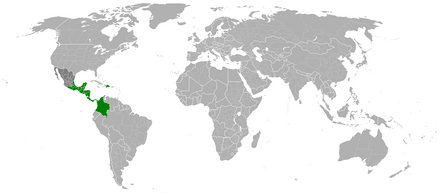Plan-Puebla-Panamá
The Plan-Puebla-Panamá ( PPP for short ) is a plan for the development of the Central America region . It was introduced in 2001 by the Mexican President Vicente Fox . Because of the massive criticism of the project, it was no longer actively promoted until Felipe Calderón put it back on his political agenda in 2006.
content
The plan envisages expanding the infrastructure in the participating states. Roads, border crossings, mines and dams are to be built. Changes to the law and the establishment of maquilas are also included.
Officially, the plan contains projects in the following eight sub-areas:
- Sustainable development
- Human development
- Preparing for and combating natural disasters
- Expansion of tourism
- Facilitation of trade exchanges
- Expansion of the transport networks
- Electricity network
- Cooperation in the telecommunications sector
Participating regions
The Mexican states are involved:
and the Central American States:
- Guatemala
- Belize
- Honduras
- El Salvador
- Nicaragua
- Costa Rica
- Panama
- Colombia (since 2007)
partner
The following non-state actors act as partners for financing and coordination:
- Inter-American Development Bank (Banco Interamericano de Desarollo, BID)
- Central American Bank for Economic Integration (Banco Centroamericano de Integración Economica, BCIE)
- Economic Commission for Latin America and the Caribbean (CEPAL)
- Instituto Centroamericano de Administración de Empresas (INCAE)
Associated projects
- International Network of Central American Roads (RICAM)
- Central American Electricity Market ( SIEPAC )
- Establishment of a modern telecommunications network throughout Central America
criticism
The plan has been criticized as " neoliberal restructuring of the region". In 2003, a coalition of various social groups in Central America blocked roads and ports to protest against the project.
Individual evidence
- ↑ a b c d Juliane Schumacher: Plan Paraíso. In: Latin America News. March 1, 2008, accessed July 13, 2015 .
- ↑ a b c d Plan Puebla-Panamá (PPP). In: Oeko-Büro.de. November 1, 2003, accessed December 6, 2010 .
